
The responsibility of leadership is to provide direction and motivation. A leader's most important task, it would seem, is two-fold: they must set an example for others by living one's values in both words and actions; secondarily but just as importantly--a good leader knows how best to communicate these ideas so as many people understand them. To provide effective leadership, a leader needs to understand the needs of their followers.
Related Course: Leadership Course
Leaders need to identify what makes their followers feel valued and appreciated. To create a sense of motivation in followers, leaders must articulate a clear vision that inspires others to want to achieve great things. People follow leaders that they trust and admire. Without good communication, a leader will find it challenging to build up followers.
Leadership is not about having all the answers; it's about asking the right questions. A good leader knows how to bring out the best in others by making them feel comfortable enough to contribute their ideas to solve problems.
Leaders must also adapt to changes and be willing to take risks. Ultimately, the goal of leadership is to inspire others to reach their potential and achieve great things. Followers need to feel that they are part of something larger than themselves and that their efforts are contributing to a common goal. When a leader can create a sense of purpose in their followers, it can motivate them. With clear direction and a shared vision, anything is possible.
What Are Leadership Functions?
Leadership functions are often associated with the following:
Tasks - Planning Organizing
Staffing
Directing
Controlling
In this post, we will be discussing the functions of leadership and utilizing these tasks in conjunction with a marching band to realize how they contribute to maximum productivity. For those who may not know what a marching band is, a simple definition might read as follows: "a group of people performing synchronized movements while holding or wearing various types of equipment, such as drums, flagpoles, guns, etc.".
It's not just about telling people what they should do, but also figuring out how to get them there- that's why leadership functions often involve tasks such as planning and organizing so that you know where every single person needs to go for the task at hand to be completed efficiently with minimal frustration on all fronts!
In a marching band, the conductor is the leader and is responsible for planning and organizing the band's movements as they march. They ensure that every musician is correct and knows when to play their part. The staff assists the conductor by following their directions and providing that the rest of the band is kept in line. The directors are responsible for ensuring that the music is played correctly and the tempo is maintained.
Lastly, the controllers are in charge of keeping time and ensuring that everyone stays on schedule. As you can see, a successful marching band requires a lot of planning and organizing. Without these functions, the band cannot march and thus perform their show to maximum effect.
So how can we use these functions in conjunction with a band?
Planning: The band director must plan out the movements of where everyone needs to go so that they are all there when it is their time to play. They must take into account the tempo of the music and the physical limitations of each musician.
Organizing: The band director must organize the band into rows and columns so they are all in their correct places and can march together.
Staffing: The staff assists the director by following their directions and ensuring that the rest of the band is kept in line.
Directing: The director tells everyone when to play and what note they need to be playing at all times. They must also tell people where to move and how fast/slow they should go.
Controlling: The controllers are in charge of keeping time and ensuring that everyone stays on schedule. They must make sure to keep a close eye on the band director- if they are straying too far off course, they must let them know! Controllers are also responsible for ensuring that each person plays their part at the right time by closely watching the conductor's movements.
How Should Leaders Be Delegating Their Work?
Leaders should be able to delegate work effectively to focus on their responsibilities within the organization.
When it comes to leading an organization, one of the most critical skills a leader can have is delegating work effectively. Delegation allows a leader to focus on their responsibilities within the company while still ensuring that tasks are completed efficiently and effectively. However, delegation is not always easy, and many leaders struggle.
There are a few key things to keep in mind when delegating work:
1. Make sure you are clear about what you want to do.
It is essential to be clear about what you want to be done when delegating work. This means ensuring that the individual you are charging to understands the task and knows what is expected.
2. Set timelines and deadlines.
It is also important to set timelines and deadlines for the work delegated. This helps ensure that tasks are completed on time and that everyone involved is aware of the expectations.
3. Stay involved.
While it is important to delegate work, it is also essential to stay involved and periodically check in on the individual completing the work. Make sure they are making progress and offer any help or guidance necessary along the way.
When you follow these three guidelines, it will be easier to ensure that tasks are completed efficiently and effectively, even though you are not directly handling them yourself. A successful leader must also possess personal skills such as intelligence and integrity.
What Are Today’s Leadership Skills?
In today's fast-paced world, leaders must possess various skills to be the most effective. Of these numerous skills included in a leader's repertoire is a combination of personal skills, including intelligence and integrity.
Brightness is important because it allows for a leader to make informed decisions and because it indicates that they value their employees enough to be well-informed about their work. Integrity is critical because it ensures that a leader will always make decisions in the best interests of their employees, company, and customers.
Leaders who lack intelligence or integrity are more likely to make rash decisions that harm their company or employees. Conversely, by combining personal skills such as intelligence and integrity, leaders can be more proactive about initiating change in their company, which separates good leaders from great ones.
A successful leader must also possess leadership skills such as intelligence and integrity. Brightness is important because it allows a leader to make informed decisions; this attribute demonstrates that they value their employees enough to be well-informed about their work. Integrity is critical because it ensures that a leader will always make decisions in the best interests of their employees, company, and customers.
Leaders who lack intelligence or integrity are more likely to make rash decisions that harm their company or employees. By having a combination of personal skills such as intelligence and integrity, leaders can be more proactive about initiating change in their company, which separates good leaders from great ones.
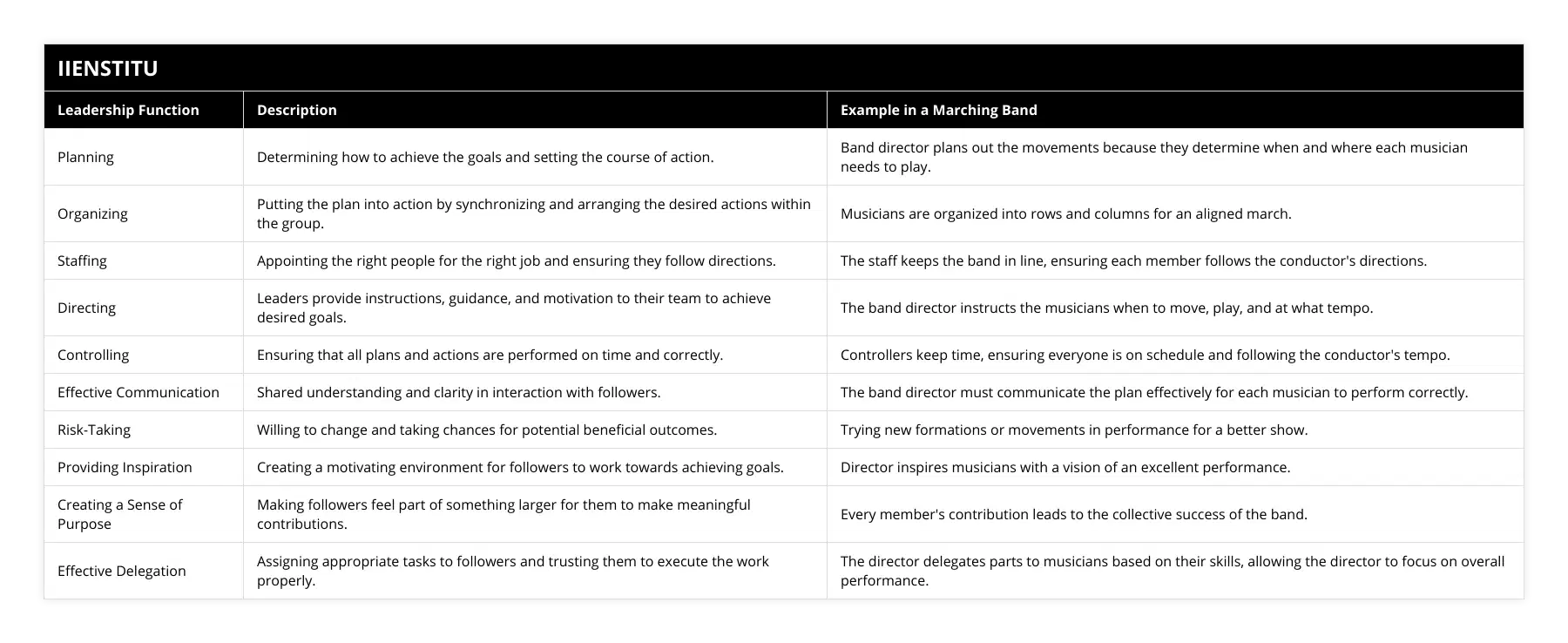
Frequently Asked Questions
What are the five functions of a leader in a professional setting?
**Leadership Functions Overview**
In a professional setting, a leader has various responsibilities that contribute to the overall success of the organization. Specifically, there are five primary functions a leader must fulfill, including providing vision, creating a motivational environment, acting as a representative, offering guidance, and ensuring accountability.
**Visionary Aspect**
One of the primary functions of a leader is providing a clear, focused vision for the organization. This involves setting long-term and short-term goals, developing plans and strategies to achieve these objectives, and communicating this vision effectively to the team. By doing so, a leader can inspire and motivate their team to work towards the collective goal, which is essential for success.
**Motivational Environment**
Furthermore, it is the responsibility of a leader to create a motivating work environment that fosters productivity, collaboration, and dedication. This can translate to implementing regular feedback loops, offering appropriate rewards and incentives, and encouraging employee development. By ensuring employees feel valued and motivated, a leader can drive them to exceed expectations and excel in their respective roles.
**Representation and Advocacy**
Another function of a leader is to act as a representative of their team or organization to external stakeholders, including clients, business partners, and other key decision-makers. This means communicating the company's values, goals, and achievements, advocating for the team's interests, and taking ownership of the team's successes and challenges.
**Providing Guidance**
In addition to providing vision and motivation, a leader must also guide their team in achieving their goals. This includes mentoring, coaching, and offering advice to team members to help them develop professionally and navigate challenges they face. Effective guidance can result in increased job satisfaction, improved performance, and stronger relationships within the team.
**Accountability Ensurance**
Lastly, a crucial function of a leader is to ensure accountability within the organization. This entails monitoring and evaluating the performance of team members, providing constructive feedback, and, if necessary, implementing corrective measures for underperforming employees. By holding each team member accountable, a leader instills a culture of responsibility and ownership, which can ultimately drive organizational success.
In conclusion, the five primary functions of a leader in a professional setting encompass providing vision, creating a motivational environment, acting as a representative, offering guidance, and ensuring accountability. By effectively carrying out these functions, a leader can propel the organization towards success and foster a productive and content workforce.
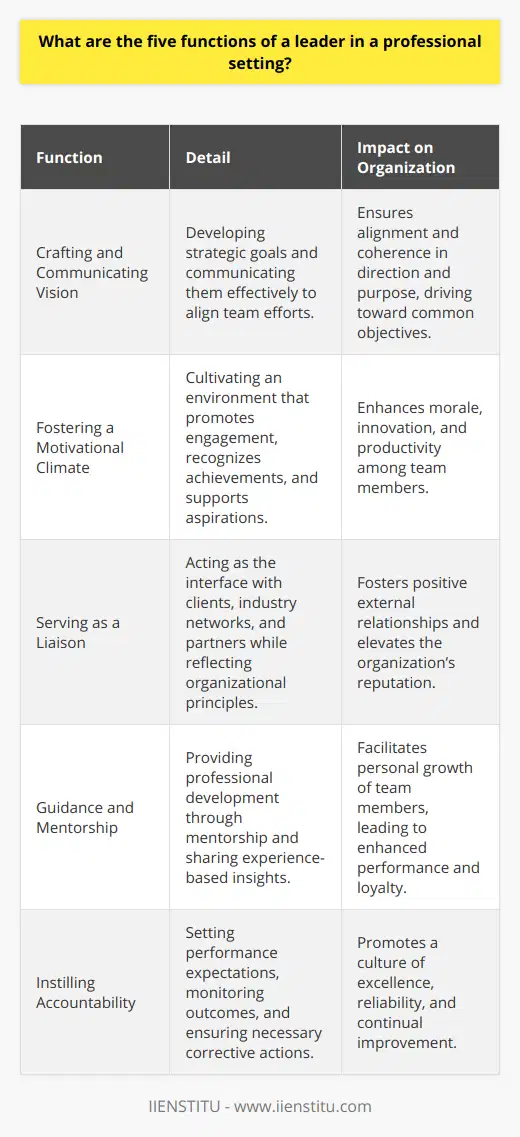
How do the eight functions of leadership contribute to the success of a team or organization?
Functions of Leadership
Effective leadership is crucial to the success of any team or organization, as it helps guide members towards achieving common goals. The eight functions of leadership contribute greatly to this success, as evidenced below.
Establishing Vision
The first step of effective leadership is to create a clear vision and direction for the team or organization. This provides a solid foundation and unifies members towards a shared purpose.
Communicating Expectations
Leaders must effectively communicate their expectations to each team member, ensuring that they understand their roles and responsibilities to achieve the vision.
Motivating Team Members
Leaders inspire and motivate their members by encouraging their strengths and instilling confidence. This fosters a positive environment that promotes maximum effort and individual growth.
Providing Support and Resources
Leaders must equip their team with the necessary support and resources to accomplish their objectives, ensuring that they have the tools and guidance to complete their tasks efficiently.
Facilitating Cooperation and Collaboration
Encouraging cooperation and collaboration aids in fostering strong working relationships among team members. This increases productivity and creates a harmonious working environment.
Monitoring Progress and Performance
Effective leaders continuously evaluate the team's progress and performance, identifying areas requiring improvement or new strategies to better meet objectives.
Adapting and Improving
Leaders must have the ability to adapt and improve their approach based on the changing circumstances or levels of performance. This flexibility helps teams navigate challenges and remain focused on achieving goals.
Empowering Team Members
Empowering team members by delegating responsibilities and providing opportunities for growth cultivates trust and strengthens each individual's contribution to the team's success.
In conclusion, the eight functions of leadership act as a catalyst for the success of any team or organization. By establishing vision, communicating expectations, motivating team members, providing support and resources, facilitating cooperation and collaboration, monitoring progress and performance, adapting and improving, and empowering team members, leaders significantly increase the likelihood of their team or organization achieving the desired goals.

How can one effectively apply the four functions of leadership in various contexts and situations?
Understanding the Four Functions of Leadership
To effectively apply the four functions of leadership - planning, organizing, leading, and controlling - in various contexts and situations, one must first understand the core principles and adaptability of these functions.
Adapting Planning to Different Contexts
In the planning function, a leader sets goals, develops strategies, and creates action plans. Adaptation in different situations requires analyzing the specific context, recognizing the unique aspects, and adjusting the plan accordingly. For instance, in a crisis, a leader needs to develop a rapid response plan, whereas, in a stable environment, long-term strategic planning is more appropriate.
Organizing in Contextual Scenarios
Organizing entails allocating resources, assigning tasks, and establishing a structure to accomplish goals. Acknowledging the resource constraints, diverse skill sets, and social dynamics in each context is vital for effective organization. A leader should be flexible in accommodating workforce diversity, operational challenges, and environmental factors to establish a functional structure aligning with the situational requirements.
Leading Dynamics Across Situations
Leading involves motivating, inspiring, and influencing individuals to work towards the set goals. Each context presents different motivational factors and leadership styles. Adapting to these situational demands requires using a tailored approach – empathetic listening, clear communication, and providing supportive feedback while embracing appropriate leadership styles, such as transformational, transactional, or servant leadership, depending on the context.
Controlling in Varied Environments
The controlling function involves monitoring performance, comparing it with the set goals, and taking corrective actions if needed. An effective leader demonstrates agility in adjusting control mechanisms and performance metrics depending on the situation. For example, in a rapidly-changing technology industry, leaders should prioritize innovation, while in traditional manufacturing sectors, quality and cost control might be more crucial.
Conclusion
In conclusion, the key to effectively applying the four functions of leadership in various contexts and situations lies in understanding the core principles of each function, analyzing the specific context, and adapting leadership approaches accordingly. By doing so, a leader can ensure successful goal accomplishment and efficient team performance in diverse scenarios.

What are the 7 functions of leadership and how do they contribute to effective management?
Functions of Leadership and Their Impact on Effective Management
Understanding Roles and Responsibilities
One of the vital functions of leadership is to understand and clearly define the roles and responsibilities of team members. This helps avoid confusion, promotes accountability, and ensures tasks are efficiently distributed among team members. Consequently, it results in better performance and improved team dynamics.
Effective Communication
The second function of leadership entails conveying the organization's vision, goals, and expectations to employees. By maintaining open channels of communication and actively engaging in dialogues, leaders foster trust and credibility, enabling employees to feel connected and motivated to contribute their best to the organization's goals.
Inspiring and Motivating Team Members
Leaders who demonstrate the ability to inspire and motivate their team members facilitate increased employee engagement and satisfaction, leading to better overall performance. Providing constructive feedback, acknowledging accomplishments, and encouraging employees to continuously learn and grow are essential components of this leadership function.
Problem-solving and Decision-making
Effective leaders make informed decisions and solve problems, ensuring the organization's progress is not derailed by obstacles. They analyze situations, consult with relevant stakeholders, and use decision-making tools to find the best possible solutions. This function aids management in making strategic choices and mitigating risks.
Developing and Coaching
The fifth function of leadership is to foster personal and professional growth of team members by providing opportunities for development and coaching. This not only helps enhance employees' skillsets but also boosts their morale and loyalty towards the organization. Stronger team capabilities lead to improved performance and efficiency.
Strategizing and Executing
Strategic thinking is a crucial aspect of leadership, which involves setting long-term goals, planning, and making decisions in line with the organization's objectives. Leaders must establish clear action plans, allocate resources, and create timelines for execution, thereby ensuring the organization's goals are effectively pursued.
Monitoring Performance and Results
Lastly, leaders are responsible for evaluating team performance and analyzing results to identify areas of improvement. By measuring and tracking progress, leaders maintain a focus on the organization's objectives and ensure necessary adjustments are made to further optimize performance and drive organizational success.
In conclusion, the seven functions of leadership, when adeptly executed, contribute to effective management within an organization. By emphasizing clear communication, motivating and developing team members, making informed decisions, and maintaining a focus on performance, leaders increase the likelihood of achieving the company's goals and strengthen overall organizational performance.
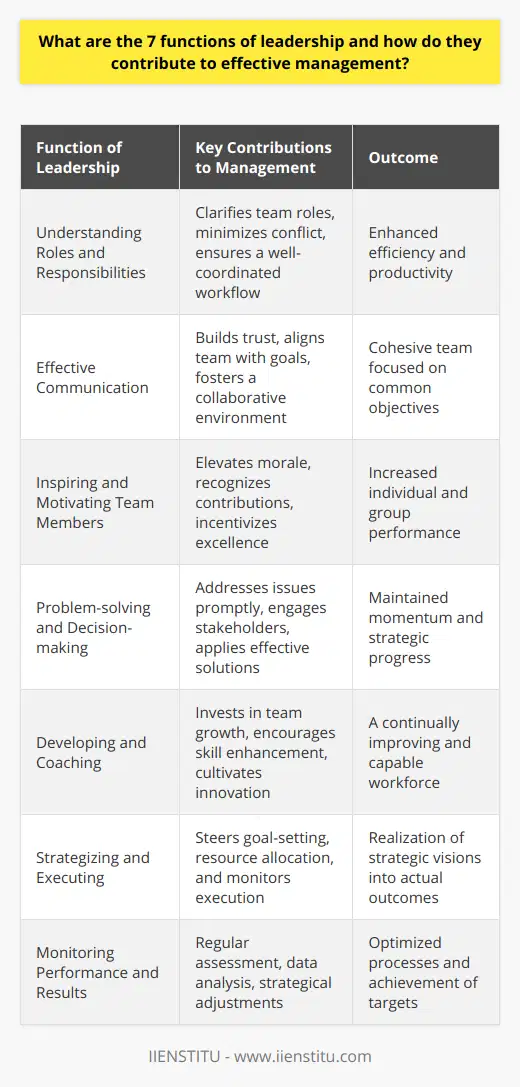
How do the 5 functions of leadership differ from traditional management approaches?
Distinguishing Leadership Functions from Traditional Management Approaches
Organizational Structures and Communication
Traditional management follows a hierarchical approach, while the five functions of leadership embrace a more collaborative, team-oriented environment. The five functions (visions, values, motivation, relationships, and networks) encourage open communication channels, empowering individuals at all levels to contribute their ideas and perspectives. In contrast, the conventional management approach relies on strict chains of command, resulting in reduced employee involvement in decision-making.
Values and Motivating Employees
The second key difference lies in how motivation is executed. Traditional managers utilize extrinsic rewards, such as financial incentives, promotions, and bonuses, to motivate employees. On the other hand, visionary leaders tap into the intrinsic needs and aspirations of their team, aligning their personal and professional values with the company's overall goals. This generates a sense of purpose and commitment among team members, which is not typically achieved in traditional management models.
Fostering Relationships and Emotional Intelligence
Leadership's relational function significantly contrasts with the transactional nature of traditional management. Effective leaders prioritize emotional intelligence, empathy, and communication skills to foster positive relationships with their team, colleagues, and stakeholders. Conversely, traditional managers tend to focus on task completion and objective measurements, often neglecting the importance of interpersonal relationships and emotional well-being in driving organizational success.
Adaptability and Innovation
Another primary difference between the two approaches can be found in how they deal with change and innovation. The five functions of leadership emphasize adaptability, resilience, and continuous improvement. Visionary leaders are proactive in identifying new trends, opportunities, and threats that may impact their organization. On the other hand, traditional management systems may be more risk-averse and resistant to change, which can hinder organizational growth and competitive advantage.
Networks and Collaboration
Lastly, the networking function in leadership accentuates the significance of fostering collaborative relationships both inside and outside the organization. This is exemplified through strategic partnerships, cross-functional teamwork, and knowledge sharing. In contrast, traditional management approaches can often foster a more siloed and competitive work environment, putting less emphasis on collaboration and sharing of information.
In conclusion, five crucial leadership functions clearly set them apart from conventional management methods, addressing key aspects of organizational success. The primary distinctions lie in the way leaders approach communication, motivation, emotional intelligence, adaptability, and networking. Embracing these leadership functions, organizations can thrive in today's rapidly evolving business landscape.

In what ways does understanding the four functions of leadership enhance a leader's ability to influence and motivate their team?
Understanding the Functions of Leadership
To effectively influence and motivate a team, a leader must have a comprehensive grasp of the four essential leadership functions: establishing direction, aligning people, motivating and inspiring others, and leading by example. A deep understanding of these functions not only enhances a leader's ability to guide their team but also helps them make informed decisions and implement strategic plans that will benefit the entire organization.
Establishing Direction
A key aspect of leadership involves setting a clear vision and strategic goals for the team. By understanding the importance of direction-setting, leaders can effectively communicate the organization's objectives and inspire their team to work together in achieving these goals. Moreover, this understanding enables leaders to anticipate challenges and adapt their vision as necessary, leading to a more dynamic and resilient organization.
Aligning People
An effective leader understands the importance of aligning individuals and teams within the organization. This involves the coordination of team efforts, building cohesion, and fostering a shared understanding of goals and objectives. By comprehending this function, a leader can effectively ensure that all team members are on the same page, working collaboratively to achieve the organization's vision.
Motivating and Inspiring Others
A leader's ability to influence and motivate their team is significantly enhanced through understanding the motivational aspects of leadership. Recognizing the importance of creating an environment that fosters enthusiasm, drive, and commitment helps leaders to engage their team members on a deeper level. Also, by knowing how to tailor their communication strategies and recognizing the uniqueness of each individual, leaders can effectively inspire each team member to reach their full potential.
Leading by Example
Lastly, a thorough comprehension of the 'leading by example' function allows leaders to model the attitudes, behaviors, and values they want their team members to emulate. By practicing what they preach and actively demonstrating commitment, integrity, and passion, leaders can effectively foster a culture of trust, accountability, and excellence. When a leader leads by example, they create an environment where team members feel motivated to contribute meaningfully, ultimately leading to increased productivity and success.
In conclusion, understanding the four functions of leadership is vital in enhancing a leader's ability to influence and motivate their team. By establishing a clear direction, aligning individuals and teams, motivating and inspiring others, and leading by example, a leader is better equipped to shape a positive organizational culture, improve team performance, and drive success.

What are the 8 functions of leadership, and how do they impact an organization's overall effectiveness?
**Overview of Leadership Functions**
The eight functions of leadership are vital aspects of an organization's overall effectiveness. They include setting vision, creating strategy, providing resources, building relationships, empowering employees, developing talent, monitoring performance, and facilitating change.
**Setting Vision and Creating Strategy**
Firstly, leaders are responsible for setting a clear vision for the organization. This involves defining the purpose, goals, and objectives to guide the organization in achieving its mission. A well-articulated vision influences workers' motivation and commitment, contributing to the overall effectiveness of the organization. Simultaneously, leaders must create a sound strategy to execute the vision, ensuring that all initiatives align with the organization's objectives.
**Providing Resources and Building Relationships**
Effective leadership necessitates the provision of adequate resources to facilitate the realization of the organization's goals. Leaders must allocate funds, time, and personnel appropriately, ensuring the optimal utilization of resources. Additionally, leaders must cultivate strong relationships with various stakeholders inside and outside the organization, such as employees, suppliers, and customers. Positive relationships contribute to a supportive work environment and foster collaboration, directly impacting the organization's effectiveness.
**Empowering Employees and Developing Talent**
Employee empowerment is a critical function of leadership. Leaders must delegate authority responsibly, entrust decision-making power, and encourage initiative among employees. Empowered employees are more engaged, innovative, and committed to the organization, leading to improved effectiveness. Moreover, leaders must prioritize talent development to foster skill improvement, address performance gaps, and prepare employees for future challenges. A skilled workforce, coupled with effective leadership, enhances the organization's overall performance.
**Monitoring Performance and Facilitating Change**
Leaders are tasked with monitoring the performance of their teams and the organization as a whole. This involves setting performance metrics, providing feedback, and holding employees accountable for their results. By continually assessing performance, leaders can identify issues and implement corrective measures to maintain organizational effectiveness. Lastly, leaders play a pivotal role in facilitating change. They must recognize the need for change, communicate its importance, and guide employees through the transition process while mitigating resistance. Adaptability to change is crucial in today's rapidly evolving business landscape, and effective leadership helps organizations stay ahead of the curve.
In conclusion, the eight functions of leadership have a profound impact on an organization's overall effectiveness. From setting a vision to facilitating change, leaders must excel in these critical areas to cultivate a high-performance work culture and drive organizational success.
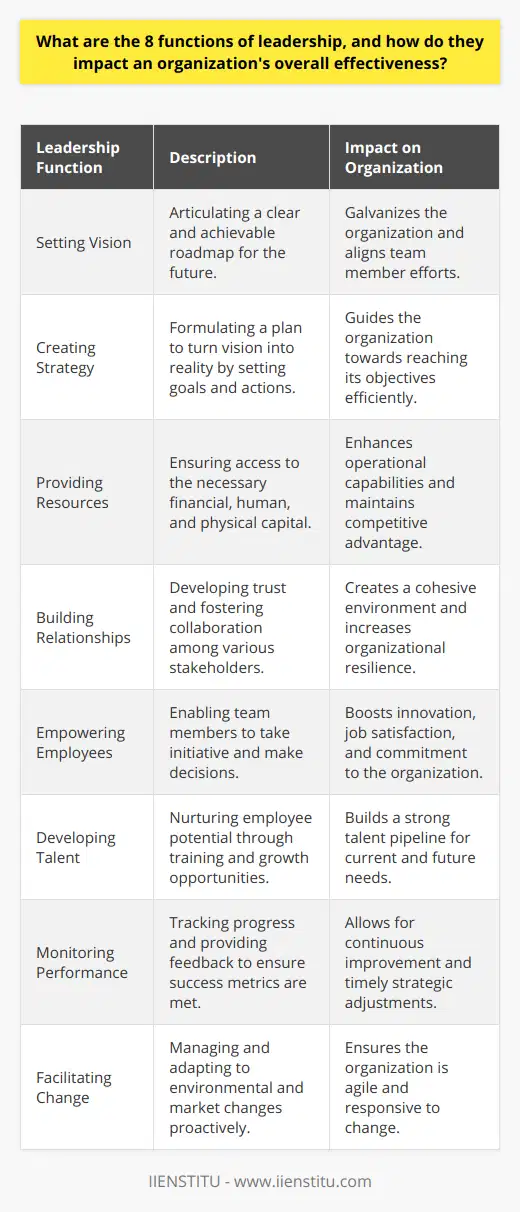
In what ways can a thorough understanding of the 7 functions of leadership improve decision making and problem-solving skills in a leader?
Understanding Leadership Functions
A thorough understanding of the seven functions of leadership enhances decision-making and problem-solving skills in a leader by providing a comprehensive framework to analyze various situations and develop effective solutions.
Effective Communication
Firstly, knowing how to communicate well enables a leader to articulate their thoughts, expectations, and goals clearly, reducing the potential for confusion and errors. This facilitates better decisions, as everyone involved has a solid understanding of the objectives and strategies.
Goal Setting and Monitoring
Secondly, setting achievable and meaningful goals allows leaders to focus their resources and attention on desired outcomes. By consistently monitoring these goals, leaders can identify potential problems early and adapt their strategies to remain on track.
Delegation and Empowerment
Thirdly, effective delegation and empowering team members develop a shared sense of responsibility and ownership. Leaders who understand how to harness the strengths of their workforce can delegate tasks efficiently, increasing the overall capacity of the team and improving problem-solving abilities.
Conflict Resolution
Fourthly, conflict resolution skills enable leaders to identify and address issues between team members swiftly. A harmonious working environment enhances productivity and fosters constructive collaboration, ultimately helping leaders make better decisions that benefit all parties involved.
Motivation and Inspiration
Fifthly, knowing how to motivate and inspire their team members allows leaders to maintain morale and resilience during challenging times. This emotional support encourages members to contribute innovative ideas and solutions, leading to improved problem-solving capabilities.
Adapting to Change
Sixthly, the ability to adapt to change quickly and confidently enables leaders to navigate uncertain situations and capitalize on new opportunities. A leader who can embrace change and guide their team through transitions is more likely to make informed decisions and solve problems effectively.
Continuous Learning
Lastly, a commitment to continuous learning and improvement aids the development of a leader's decision-making and problem-solving skills. By staying informed about global trends, emerging technologies, and industry best practices, leaders can make well-informed decisions that keep their organizations competitive and agile.
In conclusion, understanding the seven essential leadership functions allows leaders to tackle various challenges more effectively by fostering better communication, goal-setting, and collaboration among team members. These skills ultimately culminate in more informed decision-making and effective problem-solving capabilities crucial for organizational success.
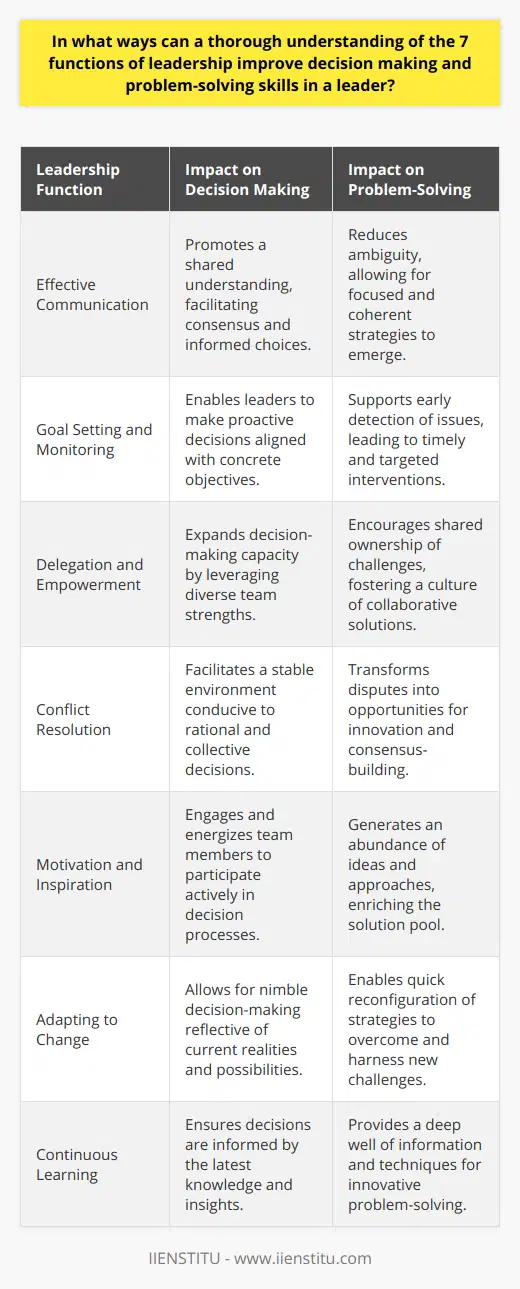
How do the 5 functions of a leader foster a positive organizational culture and promote adaptability in the face of change?
Functions of a Leader in Fostering Positive Culture
Effective communication is crucial for a leader to foster a positive organizational culture. By actively listening, conveying clear expectations, and providing timely feedback, leaders encourage open dialogue, which promotes understanding and trust among team members. This, in turn, facilitates a more agile and adaptable workforce, ready to embrace change.
Emotional intelligence is another critical aspect of leadership that contributes to creating a positive organizational environment. By showing empathy and understanding, a leader helps create a supportive and inclusive atmosphere. Moreover, self-awareness and the ability to manage one's emotions underpins a leader's capability to maintain composure during change, demonstrating the resilience necessary to adapt in the face of challenges.
Creating a Shared Vision
A visionary leader establishes a shared understanding of the organization's goals and objectives. By fostering a drive towards a common purpose, a leader can positively influence the cultural landscape, empowering individuals to work collaboratively, support each other, and effectively adapt to changes in the organization.
Decision-making and Problem-solving
A leader's decisiveness and competence in solving problems are crucial for promoting adaptability within the organization. By analyzing situations, making informed decisions, and addressing conflicts with a constructive approach, a leader can navigate through change and uncertainty. Furthermore, through a collaborative decision-making process, team members become more receptive to change, understanding the reasons and benefits of the proposed solutions.
Empowering and Motivating
An empowering and motivating leader is essential in promoting an adaptive culture within an organization. By providing opportunities for personal and professional development, a leader helps employees gain the skills and knowledge needed to respond to change effectively. Encouraging self-expression, autonomy, and personal growth are also vital in enabling employees to feel valued, fostering a positive organizational culture that nurtures adaptability.
In conclusion, the five functions of a leader—effective communication, emotional intelligence, creating a shared vision, decision-making and problem-solving, and empowering and motivating—foster a positive organizational culture while promoting adaptability in the face of change. It is through these key leadership functions that organizations can successfully navigate the complexities and uncertainties in today's dynamic business environment.

What are the 7 functions of leadership, and how do they shape the development and growth of subordinates?
Seven Functions of Leadership
Effective leadership encompasses seven key functions, which all play a pivotal role in fostering the development and growth of subordinates. These functions include establishing a vision, directing and managing resources, inspiring and motivating, fostering collaboration, ensuring accountability, fostering growth and development, and finally, providing support.
Establishing a Vision
Leaders are responsible for setting a clear and inspiring vision for their team members. This vision serves as a roadmap for subordinates, guiding their actions and decisions towards the achievement of common goals.
Directing and Managing Resources
Leaders must effectively coordinate and allocate resources, including personnel, time, and money. This enables subordinates to focus on their tasks without being overwhelmed or lacking the necessary tools to perform.
Inspiring and Motivating
Leaders are charged with the task of energizing their team members, inciting them to reach their full potential and exceed expectations. This motivates subordinates to remain committed to their tasks and to put forth their best efforts.
Fostering Collaboration
Effective leadership promotes teamwork and collaboration among subordinates. By creating an environment that encourages open communication and cooperation, leaders can stimulate innovation and ensure that collective goals are met.
Ensuring Accountability
Leaders hold subordinates accountable for their actions, responsibilities, and performance. This fosters a culture of accountability where team members understand the importance of meeting expectations and delivering results.
Fostering Growth and Development
Leaders recognize the value of continuous learning and improvement. By providing opportunities for professional development, leaders contribute to the long-term growth and advancement of their subordinates, as well as the success of the organization.
Providing Support
Finally, effective leaders offer guidance and support to their team members, addressing personal and professional challenges that may arise. This allows subordinates to feel confident in their ability to overcome obstacles and succeed in their roles.
In conclusion, effective leadership encompasses a diverse range of functions that shape the development and growth of subordinates. By embracing these leadership responsibilities, leaders can create an environment in which team members thrive and contribute to the overall success of the organization.
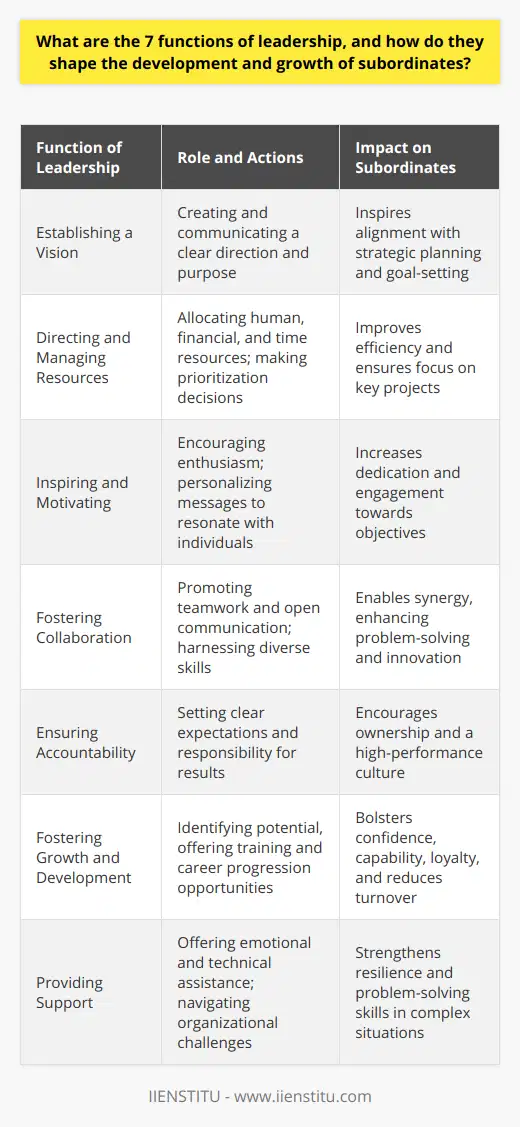
How do the 5 functions of a leader synergize to create a cohesive and efficient team dynamic?
Synergy in Leadership Functions
Effective leadership entails mastering and synergizing five essential functions in order to create a cohesive and efficient team dynamic. These functions include setting a clear direction, creating alignment, fostering commitment, facilitating collaboration, and monitoring progress.
Setting a Clear Direction
Establishing a unified vision for the team is the foundation upon which all other leadership functions can synergize. A clear direction enables team members to understand their objectives, prioritize tasks, and make informed decisions in line with the overarching goals of the organization.
Creating Alignment
Alignment is key to ensuring that individual team members' efforts support the common goals. A leader's capacity to create alignment allows for the optimization of resources, the mitigation of conflicting priorities, and ultimately, the synergy of the team's various components.
Fostering Commitment
In a cohesive and efficient team, members display wholehearted commitment to the collective objectives. A leader facilitates this commitment through consistent communication, transparency, and by role modeling the dedication and discipline needed to attain the shared goals.
Facilitating Collaboration
Collaboration is essential when aiming for a seamless team dynamic. A leader must be adept at fostering a culture of openness, trust, and mutual support among team members. Authentic collaboration is marked by a willingness to share knowledge, resources, and ideas for the benefit of the collective outcome.
Monitoring Progress
Regularly evaluating the team's progress ensures accountability and ongoing optimization of efforts. A leader who effectively monitors progress identifies gaps, provides feedback, and maintains momentum, ensuring that each team member understands their role in achieving the collective goals.
Conclusion
In conclusion, the synergy of these five critical functions empowers leaders to create a cohesive and efficient team dynamic. By embracing and exemplifying these functions, leaders set the stage for teams to surpass individual achievements and collectively contribute to the broader organization's success.
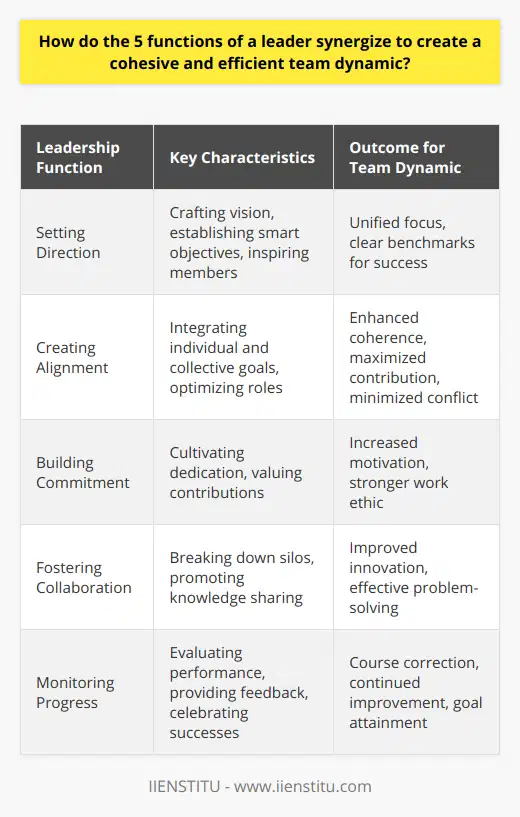
In what ways do the 8 functions of leadership contribute to long-term organizational success and sustainability?
Leadership Functions Impact on Success
The eight functions of leadership serve as vital drivers for sustaining long-term organizational success and stability. These functions provide a comprehensive approach to optimize performance, create a compelling vision, and maintain a thriving culture.
Strategic Direction and Vision
Firstly, effective leadership establishes strategic direction and vision, enabling organizations to navigate complex environments and adapt to ever-changing market conditions. This foresight ensures long-term viability and growth, fostering a shared commitment to future goals.
Planning and Organizing
Secondly, the planning and organizing function thrives on developing clear, actionable plans. By articulating expectations and setting priorities, the organization can allocate resources efficiently, leading to greater operational excellence and sustainable success.
Driving Execution
Thirdly, driving execution plays a crucial role in translating plans into tangible outcomes. By empowering team members, holding them accountable, and addressing obstacles, leadership can propel the organization towards sustained goals achievement.
Performance Management
Moreover, effective performance management practices involve setting expectations, providing feedback, and recognizing contributions. This enhances individual and collective productivity, aligning the workforce with organizational objectives and reinforcing continuous improvement.
Fostering Teamwork
Fostering a collaborative culture is critical for success as it facilitates information sharing and coordinated decision-making. Leaders who champion teamwork can leverage diverse perspectives, thereby promoting resilience and adaptability in the face of challenges.
Empowering Team Members
Empowering others is a strong indication of visionary leadership. When team members feel valued and supported, they are more likely to demonstrate commitment, engagement, and creativity – contributing to organizational innovation and competitive advantage.
Building Relationships
Strong interpersonal relationships are the cornerstone of trust and loyalty within the organization. By cultivating these connections, leaders can enhance collaborations, ensuring efficient problem-solving and effective conflict resolution, driving long-term success.
Influencing and Inspiring Others
Lastly, an influential leader inspires confidence and enthusiasm, fostering a committed workforce. This motivation bolsters resilience during challenging periods and enhances organizational culture, ultimately propelling the organization towards sustainable success.
In conclusion, the eight functions of leadership intertwine to create a powerful formula for long-term organizational success. By incorporating these functions consistently, effective leaders pave the way for enduring growth and sustainability, maintaining an advantage in a rapidly evolving business landscape.



